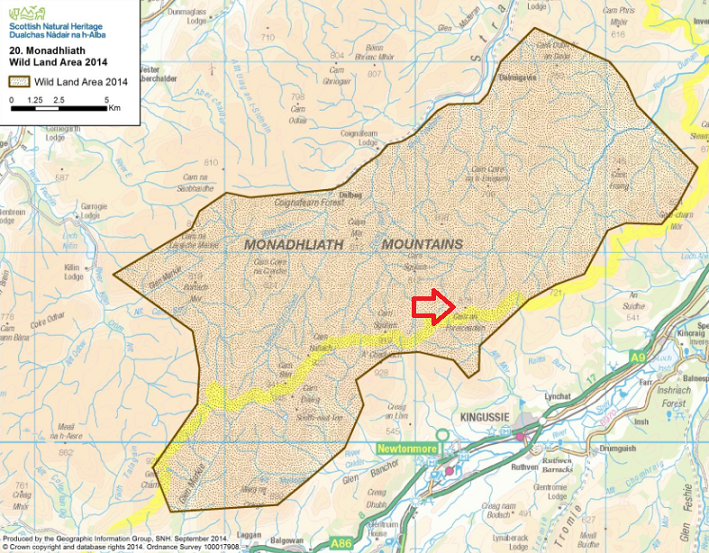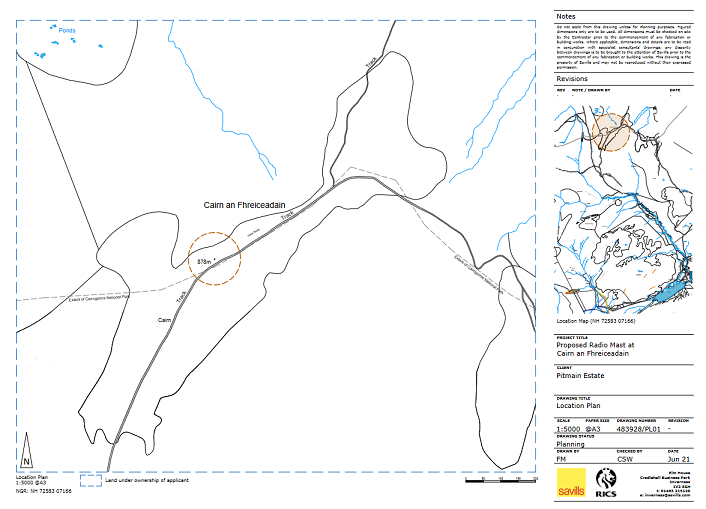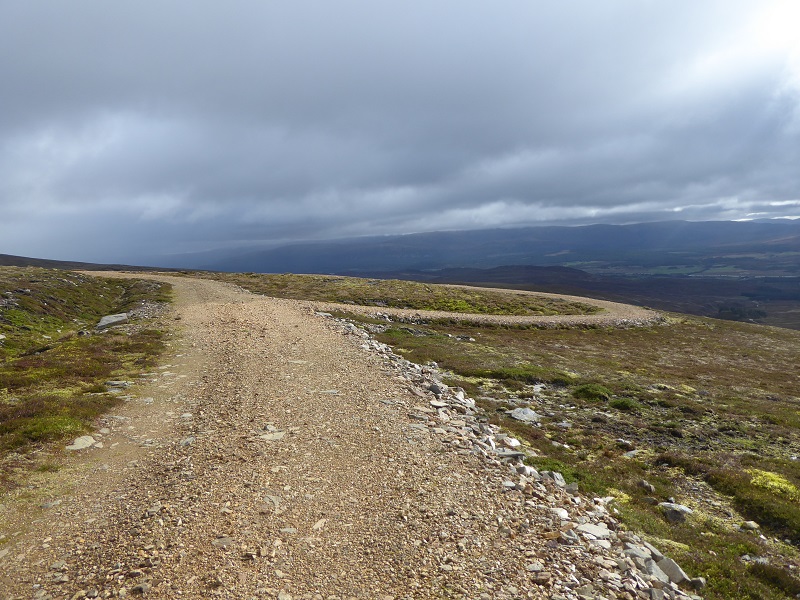
Development for “sporting” purposes on the Pitmain and Glenbanchor estates in the Cairngorms National Park, albeit interspersed with some tokenistic conservation projects funded by our public authorities (see here), is relentless.
On 8th October Highland Council validated a planning application (see here), submitted by Savills, to erect a 6m high lattice radio mast and equipment cabinet by the summit of Carn an Fhreiceadain, a Corbett north of Kingussie.
The planning application consists of three brief documents: the standard application form, a site layout plan and a location plan. The location plan shows the proposed site of the mast lies a few feet outside the Cairngorms National Park Authority boundary:

The proposed location of the mast means that the Cairngorms National Park Authority (CNPA), which has specific statutory duties to protect the landscape, is unable to call-in the planning application for a decision. They can, however, still comment on it and I hope they will object as strongly as they have done to proposals to build windfarms in the Monadhliath that would be visible from within the National Park.
Savills fails to mention in the planning application that the proposed mast lies within the Monadhliath Wild Land Area and makes no attempt to evaluate the likely impact. The description of the Wild Land Area, published in 2017, states that among its qualities are:
An extensive, simple interior with few human artefacts, contributing to a perceived ‘emptiness’ and a strong sense of naturalness, remoteness and sanctuary
Carn an Fhreiceadain, “Hill of the Watch”, has for some time been afflicted by hill tracks which extend to the very summit and continue to be “improved”.

But past damage doesn’t justify making the situation worse. That would happen if this 6m high new human artefact was added into the landscape. Even in conditions of extensive snow cover when the tracks were hidden you would be faced with a blot at the top.
The justification in the Planning Application for the mast is brief:

No map is provided of the area that is outwith mobile phone reception at present and which would be covered by a radio transmitter located on the summit of Carn an Fhreiceadain – Highland planners need to question this.
But there appears no justification for the proposal on health and safety grounds. Provision of satellite phones and locator beacons to estate staff would allow them to communicate in an emergency or to be found in the case of an accident. The estate clearly needs to put in place some basic reporting systems so that if staff are out on the hill and don’t return someone responds. None of this requires a radio mast. Pitmain’s apparent owner, Majid Jafar Chief Executive of Crescent Petroleum, clearly does not lack the money to provide his estate staff with the necessary equipment.
It would seem, therefore, that there could be other reasons for the application, which is only “predominantly” on health and safety grounds. Highland Council should now insist that Savills makes public what those other grounds for the application are.
One possibility, that crossed my mind after reading about the estate on GunsOnPegs (see here) is that it is to enable grouse shooters to chat to each other while waiting on the hill:

If you want to see the impact that the “uncompromising quality” of grouse shooting has had on Carn an Fhreiceadain take a look on google earth (see here). Tracks and muirburn have destroyed the landscape and natural habitats. The grouse shooting lobby is blind to this and the impact of their “pleasure”. The proposed radio mast may be outwith the Cairngorms National Park boundary but the sporting land management practices that lie behind the planning application take place within it.
If you want to help protect the Monadhliath Wild Land Area you can object to the Pitmain radio mast Planning Application here.

“But there appears no justification for the proposal on health and safety grounds. Provision of satellite phones and locator beacons to estate staff would allow them to communicate in an emergency or to be found in the case of an accident. The estate clearly needs to put in place some basic reporting systems so that if staff are out on the hill and don’t return someone responds. None of this requires a radio mast. Pitmain’s apparent owner, Majid Jafar Chief Executive of Crescent Petroleum, clearly does not lack the money to provide his estate staff with the necessary equipment. It would seem, therefore, that there could be other reasons for the application, which is only “predominantly” on health and safety grounds. Highland Council should now insist that Savills makes public what those other grounds for the application are.” Very good points Nick. The estate are ‘at it’.
Nick please forgive me drawing a parallel to further inform people about what can happen. .
An identical planning pathway was pursued some years ago for a 6+ m Estate communications mast. The same “lame” excuse- that it was required for communication with Estate workers while out on the hill was rolled out.( Hill estates know that employees lacked any means of communication for centuries previously,and had no use of it.). This ‘due care’ tactic has been proven to defeat any planning system on H&S grounds alone.
The following tale may help demonstrate how this sort of Trojan horse approach has worked before, and the things it can lead to may even benefit from development grants at every stage.
In this case , some15 years ago, a mast structure appeared high above a remote “scenic” lochside . No planning application to cover it had ever been sought. When concerned locals remarked to local authorities about it, only then was a retrospective application under land management provisions submitted. This claimed the structure was a simple “communications mast”. Yet observant Locals, alert to wind exploitation, could spot the mast carried an anemometer array. When once again challenged about it, the estate claimed this extra feature was simply for ecological reasons. It was a good use of an ‘existing structure’ to add to local scientific knowledge for ecological, ornithological and environmental purposes.
Of course local people are not that daft.
Just as many here suspected… Very soon after this a hill track nearby was excavated ( under permitted development) Along it the first ( of 3) modest Windturbines for local needs was granted consent and then erected. (The 2nd and 3rd would have been installed too had the local power grid been able to absorb or perhaps export the output!. However, this tale of intrigue gets weirder. With an excess of fresh renewable energy now in place, this then triggered Government support under ‘new project eco-funding’ measures to support “green business”. which could be Partially dependent on renewable energy. Consent was obtained for a new “factory” located a mile away on the land holding of this estate..a pristine wild hillside. Today a full-blown small distillery is in place.
Heat for the process also comes from mature local forest plantations now being felled transported short distances and wood-chipped. Several Bonded maturing sheds are being erected on untracked hillsides where land is cheap. Of course the eventual consumers of the “laid down” up-market product will always be many hundreds even thousands of of miles distant.
The factory certainly has drawn into the region some industry specialists, engineers and builders who now live here. Some local families have permanent jobs there, continuing to live in a slight spoiled but still very remote scenic region, which previously enjoyed all sorts of environmental safeguards.
All this unthinkable development (albeit not within an established national park..but arguably one region deserving of such status) lies perfectly ‘above board’ under current safeguards for Scotland’s wilder places , even when the place actually had secure year-round employment servicing the accommodation needs of those seeking wilder-places for relaxation.
Scots people do well to remain on our guard at all times.
Hi Tom, no need to forgive, this adds considerably to the post, thank you!
Enable grouse shooters to chat to each other while waiting on the hill……. what a load of rubbish you write, its obvious you dont like sporting estates, i wonder if you would have a problem with a mast if it was on feshie
I’d be very interested in hearing what you think the other reasons for installing the radio mast are, given the application states its not just about health and safety. For your information I would absolutely oppose masts on summits or other wild land areas anywhere in the Cairngorms and, if you hear of any plans for such masts elsewhere, please let me know. Nick
A similar mast structure is located on the summit of Scaraben in Caithness – with a notice on the mast stating it was erected for similar reasons to that mentioned in the above Pitmain article – namely for the supposed safety of estate workers who if in the area would be outwith mobile phone range.
A total blot on the landscape and a despoiling of the summit area.
Appreciative of the need to ensure the safety of workers, as mentioned this could also be done via the carrying of PLBs – thus freeing wild land of the intrusion of modern technology.
What has our world come to that requires everyone to be in supposed almost constant communication!
Nick, many thanks indeed for flagging this up.
There has been serious attrition of wild land since SNH first mapped wild land areas in 2014. This proposed development lies well within the Monadhliath Wild Land Area and will be highly visible from large areas of Cairngorm National Park. These are supposedly protected designations so industrialisation like this should be contrary to the CNPA Local Development Plan which says ‘the special qualities of the Park are protected from development that would significantly erode or harm them’. Of course it will be Highland Council deciding it as it is 20m outside CNPA jurisdiction but I hope they will consider the effect on the adjacent national park.
It also seems to me to be also contrary to Planning Advice Note 62 that says ‘people use familiar features to gauge the scale of a landscape, but some landscapes can seem larger than they really are because of a lack of scale indicators. A new radio telecommunication installation could act as a scale indicator and reduce the sense of space… The effect of utilitarian structures such as masts are particularly damaging in areas with wild land character – uninhabited and often relatively inaccessible countryside where the influence of human activity on the character and quality of the environment has been minimal. In these locations a mast could change a person’s whole perception of the area.’
That’s the theory anyway. As others have said, satellite phones and satellite messengers like Spot would give better comms coverage for estate workers, so I cannot see any upside from this development.
I’ve done an objection on behalf of Scottish Wild Land Group which will hopefully be up on the Highland Council planning website tomorrow. The only other objection I can see is the excellent one from George Allen of the North East Mountain Trust.
I do think this development is unusually damaging from the wild land point of view and I would urge others who care about wildness to object.
Its great the Scottish Wild Land Group has objected and I apologise for not flagging this up this proposal to the SWLG directly, Nick